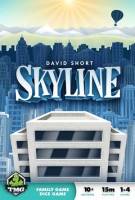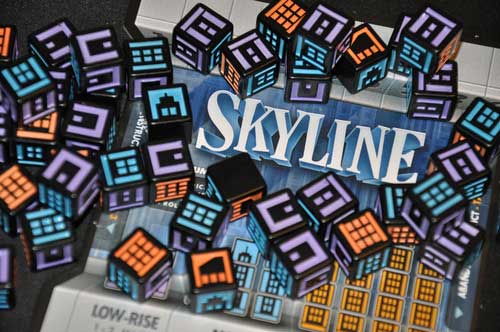
Skyline
1-4
10+
15
City building has never been so easy: Just roll the dice, then build a building. However, each die must be selected carefully to fit the building requirements. Push your luck too far – or select carelessly – and a player may find himself demolishing his city instead of building it up. Choose each die wisely and build efficiently in order to erect magnificent skyscrapers and create the best skyline!
Skyline is a quick push-your-luck dice game involving set collection. Unlike other dice games that provide no relationship from turn to turn and no player interaction, this game allows players to literally build upon their decisions each turn and react to their opponents' actions.

images © David Short, Tasty Minstrel Games
User Reviews (2)
Add a Review for "Skyline"
You must be logged in to add a review.

Every gamer needs that simple, non-brain wrinkling game that fills some time between other, more hardcore offerings on game night. That simple game that takes less than a minute to teach, doesn’t take up much time to play, and literally doesn’t try to be anything other than what it is – a simple game.
Skyline is that game. A press-your-luck dice roller in which you try to construct more buildings than your opponents over the course of nine rounds. You have three different sets of dice – ground floor dice, middle floor dice and penthouse dice. Each round, you pick dice from the central pools (known as the Construction Yard) — it could be all ground floor dice if you want or a combo of ground, middle and penthouse dice, it just depends on what you’re going for this particular round. There are three types of buildings you can build – low-rise (1 or 2 stories), mid-rise (2 to 4 stories), and high-rise (3 to 6 stories). Each is built using their specific color (purple, blue, orangish-yellow). No mixing/matching allowed.
The game play itself: Roll the dice. Keep any you want, then roll again. Keep any you want, then roll again. You can roll any number of the dice up to three times on your turn. Once you have completed a building, you turn in the dice and place a building’s scoring marker in its place. That’s it. Repeat this process over and over again for nine rounds.
There are two options in the game that, even through repeated readings, I have yet to figure out why you would use them. 1) There is a set of three dice (ground, middle and penthouse) laid to the side of the small round marker board that is called the Abandoned District. Instead of using all your dice, you could place them here for someone else to use. 2) You can demolish a building (either a set of dice or a finished structure). I have no idea why you would want to do that when you’re going for the highest score, but it’s an option.
That’s the game. Choose the dice you want to use, roll, build buildings, claim points. Simple. Easy. Mind-numbingly repetitive.
PROS
– Simple and easy to teach
– Takes only 10 or 15 minutes to play
– Lots and lots o’ dice
CONS
– Quality Control: Lots of dice are not painted correctly or paint has worn off before ever opening the baggies.
– Repetitively redundant
– Unexplained options that, on the outset, make no sense to gameplay/strategy
This is not an award-winning game. It was originally a freebie that came with another game if you funded it on Kickstarter. And it feels like it. It’s fun once. Maybe twice. But not much longer than that in an evening. Bring it out every so often, but like unwanted guests at a house party, it will overstay its welcome very quickly.
I got this game as a Kickstarter stretch goal and to be quite honest I never would have picked it up otherwise. I am not a dice game kind of guy, because I such at rolling dice. I’m glad I got it though.
This game is very simple to teach and play and depending on the number of players, it can be a very quick game.
You can play solo with the basic scoring or with goals to build certain cities like Tucson (David Short, the designer’s city), Essen and others. Those make it a nice extra challenge for a solo play.
Then you can play with more players too. The rules are very simple and I won’t get into them here. Basically you take three dice or all of the dice left over from other player’s turns and roll them.
There are lower levels, mid-level and penthouses for low-rise, mid-rise and high-rise buildings. As long as you place one die on a current or new building you can re-roll. The player who gets the most points wins based on types and Heights of buildings.
This game is for sure a filler and it does a good job of providing some decent strategy (what type of dice to take, where to place them, etc). Will I play this every week? Probably not, but if I have a small amount of time or am teaching strategy to younger players this will be my go to game.